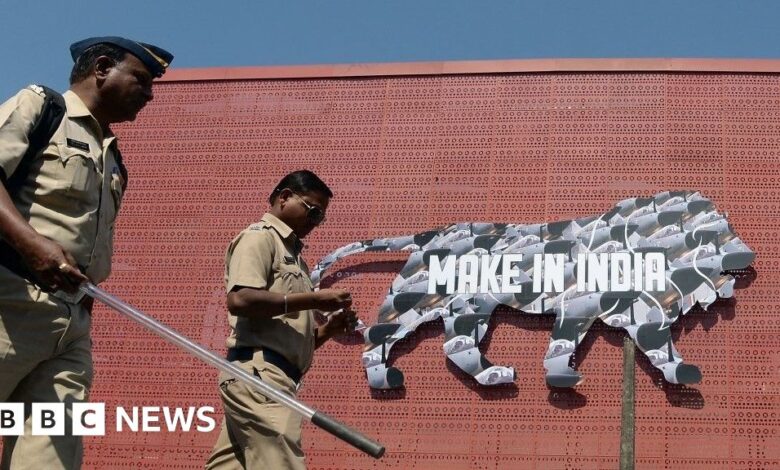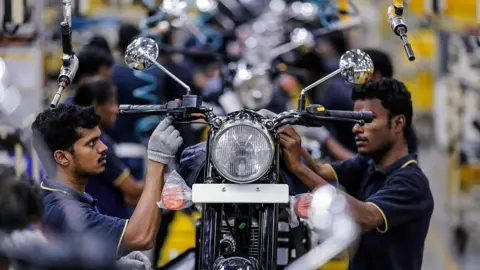Can India become rich before its population ages?

 beautiful pictures
beautiful picturesOver the past two years, Prime Minister Narendra Modi has pledged to turn India into a high-income developed nation by 2047. India is also on track to become third largest in the world economy in six years, according to some forecasts.
According to the World Bank, high-income economies have a Gross National Income per capita – the total amount of money earned by a country’s people and businesses – of $13,846 (£10,870) or more.
With a per capita income of around $2,400 (£1,885), India is among the lower income countries middle income countries. For many years now, many economists have warned that the Indian economy may be heading towards a “middle-income trap”.
This happens when a country can no longer easily achieve rapid growth and compete with advanced economies. Economist Ardo Hannson defines this as a situation where countries “seem to be stuck in a trap where your costs go up and you lose competitiveness.”
A new World Bank report raises similar concerns. At current growth rates, it would take India 75 years to reach a quarter of the per capita income of the United States, World Development Report 2024. The report also said more than 100 countries – including India, China, Brazil and South Africa – face “severe obstacles” that could hamper their efforts to become high-income nations in the coming decades.
The researchers looked at figures from 108 middle-income countries that account for 40% of the world’s total economic output – and nearly two-thirds of global carbon emissions. They are home to three-quarters of the global population and nearly two-thirds of those living in extreme poverty.
 beautiful pictures
beautiful picturesThey say these countries face greater challenges in escaping the middle-income trap, including rapidly aging populations, rising protectionism in advanced economies and the urgent need for a rapid energy transition.
“The battle for global economic prosperity will largely be decided in middle-income countries,” said Indermit Gill, chief economist at the World Bank and one of the study’s authors.
“But too many of these countries relied on outdated strategies to become advanced economies. They relied on investment for too long — or they turned to innovation too soon.”
For example, researchers say, business growth is typically slow in middle-income countries.
In India, Mexico and Peru, companies that have been operating for 40 years typically double in size, while in the United States they have grown sevenfold over the same period. This suggests that companies in middle-income countries struggle to grow significantly, but still survive for decades. As a result, nearly 90 percent of companies in India, Peru and Mexico have fewer than five employees, with only a small fraction having 10 or more employees, the report said.
 beautiful pictures
beautiful picturesGill and fellow researchers advocate a new approach: these countries need to focus more on investment, spreading new technology from around the world and developing innovation.
South Korea is a prime example of this strategy, the report said.
In 1960, per capita income was $1,200 – rising to $33,000 in 2023.
Initially, South Korea promoted public and private investment. In the 1970s, the country shifted to an industrial policy that encouraged domestic companies to adopt foreign technology and advanced production methods.
Companies like Samsung responded. Originally a noodle maker, Samsung began producing TVs for domestic and regional markets by licensing technology from Japanese companies.
This success has created a demand for skilled professionals. The government has increased funding and set targets for public universities to develop these skills. Today, Samsung is a global innovator and one of the world’s largest smartphone manufacturers, the report said.
 beautiful pictures
beautiful picturesCountries such as Poland and Chile have followed a similar path, the report said. Poland has boosted productivity by adopting Western European technologies. Chile has encouraged technology transfer to spur local innovation, famously adopting Norwegian salmon farming techniques to become a leading salmon exporter.
History offers ample clues about an impending middle-income trap. The researchers found that as countries get richer, they typically fall into the “trap” at around 10% of the US’s GDP per capita ($8,000 today), putting them in the middle-income range. That’s roughly in the middle of what the bank classifies as “middle-income” countries.
Since 1990, only 34 middle-income countries have moved to high-income status, of which more than a third benefited from integration into the European Union (EU) or newly discovered oil reserves.
Economists Raghuram Rajan and Rohit Lamba separately estimate that even with a respectable 4% growth rate in per capita income, India’s per capita income would only reach $10,000 by 2060, lower than China’s level today.
“We have to do better. In the next decade, we will see a possible population surge, that is, an increase in the proportion of the population that is of working age, before we, like other countries, suffer from ageing,” they write in their new book, Breaking The Mould: Reimagining India’s Economic Future.
“If we can create good jobs for all our young people, we will accelerate growth and have a chance to become a prosperous middle class before the population starts to age.”
In other words, economists ask themselves: “Can India get rich before it gets old?”
Follow BBC India on Instagram, YouTube, Twitter And Facebook





